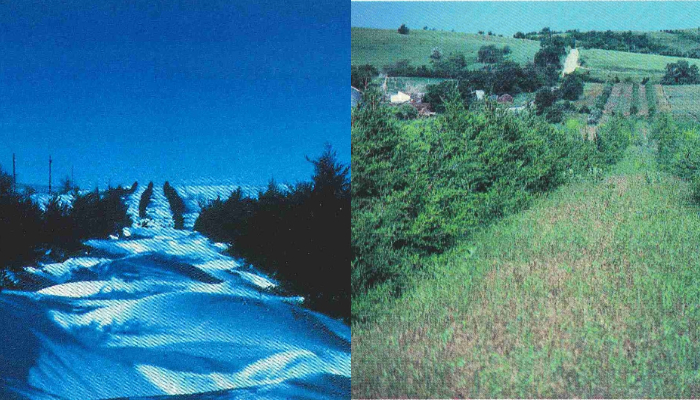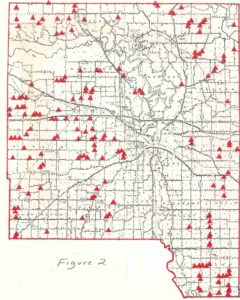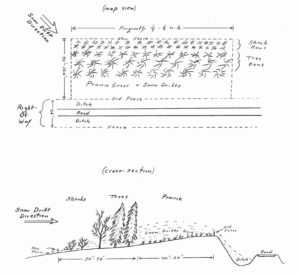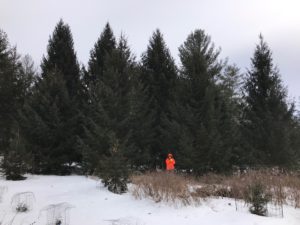Living Snowfences

A young drift catcher, winter and summer
Back in the 1980s a lot of us were promoting living snowfences to control snow drifting on the most difficult places on Iowa roads.
The theme was picked up by folks of many persuasions: County Extension offices offered pamphlets, Moose Lodges pledged support, Wallace’s Farmer magazine ran a how-to-do-it story, County Roads engineers discussed details in their meetings, County Conservation Boards passed resolutions, and nurseries mailed catalogues. Academic researchers jumped in and measured success of songbird nesting, winter survival of rabbits, berry production from the shrubs, etc., and declared them to be fine habitat. Academic engineers measured wind velocities and modeled the plantings you need to effectively drop snow where you want it. A ruling that CRP funding could be used to build them was a plus.
There was already a large selection of literature in the upper Midwest, starting from the 1930s, regarding farm windbreaks, and with minor modifications these became relevant to living snowfences.

My 1986 map of road segments most vulnerable to drifting.
Locally, Project GREEN awarded a grant to Barbara Kirchner and me to inventory the native vegetation in all of Johnson County’s road right of ways during the summer of 1983, 1984, and 1985. Since we were driving every road in the county anyway, I also mapped the road segments most vulnerable to snow drifting, and returned in the winter to field check uncertainties.
So what happened?
Well, mostly nothing. County road departments already had piles of wood slat snowfences, and a budget and crew to install them. And compared to adding some prairie seed to a CRP planting mix, growing a snowfence is work: weeding, watering, and protecting tree seedlings. Most importantly, the community of landowners was not engaged. It was mostly conservationists, naturalists, academics, agencies, etc. sharing with each other – a classic case of preaching to the choir.

My spin on the minimum planting necessary to create a living snowfence along a local country road.
And so here we are today, winding down another windy winter, and spending our tax dollars ramming roadway snowdrifts with “V” plows, instead of spending it to upgrade and supplement those living snowfences, which coulda/shoulda been planted a third of a century ago and today would be thirty feet tall – stalling the winter wind and leaving open roads in their wake.

My 30- and 20-year-old planting of Norway spruce, with a few young ones in cages in the foreground.
So how do we break the cycle of not looking beyond next winter, and how do we turn the snowdrift problem into a habitat opportunity? One way could be for conservation-minded individuals, organizations, and agencies to sponsor/plant/maintain living snowfence demos on cooperators land. Any groups doing so would also need to keep good records, especially costs, and use this information as a basis for a future subsidy program.
Bur Oak Land Trust could grow one of these, and/or could become the organizer/manager of a county living snowfence program.
Note that if you are planning a living snowfence for your acreage or driveway, and the snowshed is only 20 acres instead of 200, the volume of drifting snow will be smaller and the snow storage area downwind can be reduced.


